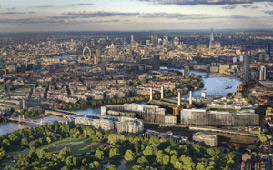Housing Market
News covering issues affecting the UK residential property market, house prices, interest rates and buying and selling trends.
-

Tories will increase number of homes available, says Housing Minister
Only a Conservative Government will continue to “support the aspirations of hard-working people, and build the homes this country needs”, according to Brandon Lewis (left), the Minister of State for Housing and Planning for Department for Communities and Local Government. In a guest column, written exclusively for the March issue of The Negotiator magazine which is out soon, the Housing Minister, Brandon Lewis, took the time to reflect on what the Coalition Government, led by the Conservatives, have achieved in this parliament. He pointed out that under the last Labour Government house building fell to its lowest peacetime levels since the 1920s, locking a generation of young people out of homeownership in the process, but that the necessary measures have now been taken to get developers building and the market moving again. He wrote: “In 2010 we inherited a broken housing market: builders couldn’t build, lenders wouldn’t lend and buyers couldn’t buy. “Fast forward to today and the landscape is very different. The numbers of first-time buyers has hit a seven-year high; planning permission has been granted on 240,000 new homes in the year to October, and house building starts are at their highest since 2007.” Mr Lewis insisted that…
Read More » -

We must build 200,000 homes a year by 2020 – FMB
The Government and property industry must collaborate to build at least 200,000 homes a year by 2020 in order to tackle the housing crisis, according to the Federation of Master Builders (FMB). The call forms part of the FMB’s “Programme for Government: 2015 to 2020” which was launched at a high profile cross-party event in Parliament last week. Brian Berry (left), Chief Executive of the FMB, said, “In England we’re only building around half the number of new homes required to meet the demand for housing. Regardless of which party or parties take the reins in May 2015, the next Government must work with industry to develop a robust housing strategy and commit to building at least 200,000 new homes a year by 2020. This is a realistic target and one that can be achieved if we remove barriers to small local builders.” The FMB’s “Programme for Government: 2015 to 2020”, was welcomed last week by the Housing and Planning Minister Brandon Lewis, Shadow Housing Minister Emma Reynolds (right) and Communities and Local Government Minister Stephen Williams, with all three MPs agreeing that far more needs to be done to boost the supply of much needed new build homes. This…
Read More » -

Scottish Government revises property tax after UK stamp duty changes
Deputy First Minister John Swinney has announced a series of changes to the Land and Buildings Transaction Tax (LBTT) – which will replace stamp duty for homebuyers in Scotland – following Chancellor George Osborne’s amends to stamp duty in his Autumn Statement in December. Among the headline amendments, is the fact that homes in Scotland worth up to £145,000 will not now attract any tax, up from the previously proposed £135,000. For sales between £145,000 and £250,000, a tax rate of 2 per cent will be applied, with the introduction of a new rate of 5 per cent between £250,000 and £325,000. Mr Swinney had previously planned a tax rate of 10 per cent on residential properties sold for between £250,000 and £1 million – prompting concerns that those acquiring family homes could be hit. However, the 10 per cent rate will be applied to properties valued between £325,000 and £750,000. The top rate of 12 per cent – which was previously going to apply to residential properties worth in excess of £1 million – will now take effect from £750,000. The Deputy First Minister defended the Scottish national Party’s (SNP) decision to change the taxes following the Chancellor’s surprise…
Read More » -

Property rental prices rise 3% in 2014
Rents in the private rental sector rose by three per cent in 2014, six times the latest rate of inflation, the latest figures from Your Move and Reeds Rains, both of whom are part of the LSL property services group show. The rise in rental prices reflects historically high demand from tenants for this time of year, supported in part by falling unemployment and rising wages. According to the data from the Your Move and Reeds Rains buy-to-let index, the average residential rent reached £767 in December, up from £745 the year before. In the East of England, Yorkshire & Humber, East Midlands and London there was no seasonal fall and new records were set. “In particular a jobs boom across the eastern regions of England has seen a larger than usual number of people relocating in the winter months,” said Reeds Rains and Your Move Director, Adrian Gill (left). “This has pushed up rental prices in these regions even further.” Rents are higher than a year ago in no fewer than eight out of 10 regions of England and Wales, led by the East of England, with a 7.6 per cent annual rise. The East Midlands has seen rents…
Read More » -

Annual home price growth falls – ONS
The latest figures from the Office for National Statistics (ONS) reveal that residential property prices rose by 10.4 per cent to an average of £271,000 in the year to the end of October 2014, down from an annual price increase of 12.1 per cent the previous month, suggesting that house price growth in the UK is continuing to tail off, especially in the capital. London yet again showed the strongest growth in prices, although the market in the capital is cooling, with annual growth falling in October to 17.2 per cent from 18.8 per cent in September. But with all the focus on the downward trend in property price growth in recent months, we are in danger of forgetting that a double-digit rise in home values over the past twelve months is “an impressive leap”, according to Peter Rollings (right), CEO of Marsh & Parsons. He commented: “After the exertions of the summer months, this is simply a period of natural re-calibration, restoring a more sustainable pace of price inflation. Growth is still ticking along in the right direction.” House price annual inflation in October reached 10.8 per cent in England, 5.7 per cent in Wales, 4.9 per cent in…
Read More » -

Housing market continues to cool
The residential property market continued to slow in December, as lower demand led to the slowest rate of property price growth since the start of 2014. The annual rate of growth slowed to 7.8 per cent, which is 2.4 per cent lower than the high witnessed in July, and the lowest since the 7.3 per cent of January 2014, the latest data from mortgage lender Halifax reveals. The quarterly rate of growth has now fallen for five months in a row, with prices in the three months to December just 0.3 per cent higher than in the previous quarter, the lowest rate of quarter-on-quarter growth since November 2012. Halifax’s figures act as a further indication that the housing market may be far more muted in 2015. Halifax estimates that house prices will rise this year by between 3 and 5 per cent, which would be around half the rate of growth seen in 2014. “The deterioration in housing affordability as a result of rising house prices, earnings growth that has been consistently below consumer price inflation until very recently, and speculation of an interest rate rise, have combined to temper housing demand since the summer,” said Martin Ellis (left), Halifax…
Read More » -

Scottish rents soar
Scottish rents rose sharply in 2014 as the market continues to see a definite trend for rented property in Scotland, new figures show. With many people struggling to raise the necessary savings required for a deposit to buy a property, they are opting to rent property instead, driving rental prices higher in the process. According to the latest Citylets report, figures to the end of December 2014 show that national rents have risen 7.9 per cent in the last year to stand at an average of £732 per month. This contrasts with just one per cent growth in the preceding year. The Scotland figure is heavily influenced by strong annual rises in three of the country’s main cities with Edinburgh at 9.5 per cent, Glasgow at 9.4 per cent and Aberdeen at 8 per cent. By contrast, Dundee registered a rise of only 3.2 per cent over the year. The fourth quarter of the year is usually the quietest time for lettings activity where seasonal falls are common. However, this year’s dip in average national rents was only £4 down from the country’s record high of £736 seen in Q3 of 2014. Commenting on the latest findings, Citylets MD, Thomas…
Read More » -

Is there any value in a mansion tax?
It has been more or less been killed off by the Chancellor's new Stamp Duty regime - but did the mansion tax ever have much currentcy?
Read More »






